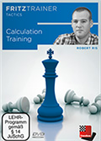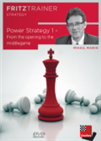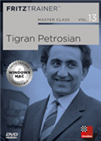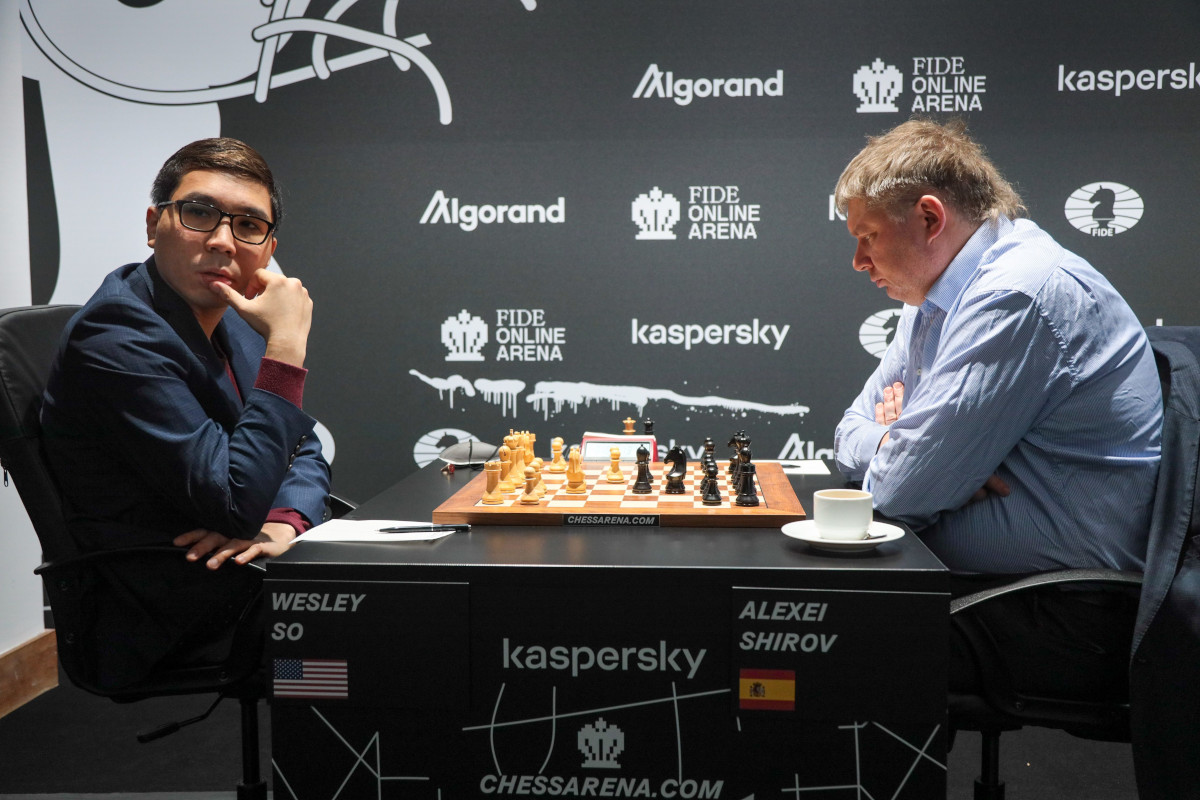So catches Dominguez
 Half the games of round 3 in Berlin finished decisively, as the group stage of the tournament hit its halfway point. With three rounds to go and only one player from each group advancing to the knockout, we expect the players to continue showing the fighting spirit that has been featured in most games so far.
Half the games of round 3 in Berlin finished decisively, as the group stage of the tournament hit its halfway point. With three rounds to go and only one player from each group advancing to the knockout, we expect the players to continue showing the fighting spirit that has been featured in most games so far.
While pools A, B and C still have sole leaders, pool D has Leinier Dominguez and Wesley So sharing first place on 2 out of 3 points. On Sunday, So inflicted a second consecutive defeat on Alexei Shirov. In Monday’s fourth round — the last one before the rest day — So will have the black pieces against Dominguez in their direct confrontation.
So was not the only player to score a win with white in round 3, as Andrey Esipenko, Vidit Gujrathi and Levon Aronian also scored full points while marshalling the white pieces. While Esipenko and Vidit bounced back from losses in previous rounds, Aronian became the first player in the event to get a second win, and is now the favourite to reach the semifinals in group C — the US grandmaster has a full point lead over second-placed Vidit.
Pool A: Grischuk the entertainer
While his compatriot Andrey Esipenko got the better of Etienne Bacrot, Alexander Grischuk struggled both with the clock and with his position in his game against Hikaru Nakamura. Once the sharp struggle ended in a draw, press officer Michael Rahal asked Nakamura how he felt about his chances going into the last three rounds of the group stage. After hearing the American’s response, Grischuk added:
Also, there are three more PCR tests, so everything is ahead (smiles).
Grischuk not only entertained the spectators with his good sense of humour, but also with the sharp lines he entered during his game against the group’s leader.
The Russian had already spent 20 minutes on move 12 and 25 minutes on move 14, but that did not prevent him from choosing the sharp 18.Nxb7 in the diagrammed position — and, yes, he took his time, specifically 14 minutes, before deciding to enter the complications.
White recovered the piece and ended up a pawn to the good with 18...Bxb7 19.Rc7 Bc6 20.Rxe7. However, after 20...Bb6 21.Kf1 a5 it is difficult to figure out how the white rook on the seventh rank will escape a potential ...Kf8.
 This DVD emphasizes the importance of training your calculation skills. Dutch IM Robert Ris made a selection of training material which he uses in lessons with students ranging from 1400 to 2400.
This DVD emphasizes the importance of training your calculation skills. Dutch IM Robert Ris made a selection of training material which he uses in lessons with students ranging from 1400 to 2400.
Luckily for Grischuk, 22.Rc1 barely keeps things under control — note that by this point he was already in deep time trouble. There followed 22...Be4 23.Rc4 Kf8
White gave up an exchange, but still had an extra pawn, the bishop pair and an active rook as compensation. Both contenders continued to make precise moves until signing a draw by agreement on move 31.

Still in the lead — Hikaru Nakamura
Pool B: Wild games, Wojtaszek leads
With Vladimir Fedoseev and Richard Rapport playing uncompromising chess from the get go, group B has featured some of the most entertaining chess so far in Berlin.
In round 3, Rapport had the black pieces against underdog Grigoriy Oparin. The Hungarian was on the better side of a materially imbalanced position, but unlike in the previous round, he failed to convert it into a win. Credit should be given to Oparin, who defended resourcefully from an uncomfortable position until getting the draw in a lengthy 60-move game.
Meanwhile, in the game between Fedoseev and group leader Radoslaw Wojtaszek, a double-edged position appeared on the board right out of a somewhat peculiar opening.
Note that Black pushed his f-pawn early on and placed his rook on f8 without castling — which is, in fact, an idea that has been tried recently with good results for black. At this point, White needed to deal with potential knight jumps to f2 or e3, and saw it necessary to continue with the cautious 15.Rd2.
However, as Fedoseev mentioned afterwards, he could have played the developing 15.Nh3, since 15...Ne3 fails to 16.Nxd6+ exd6 17.Rhe1, pinning the knight.
The Russian’s miss gave Wojtaszek the upper hand, and the Polish grandmaster quickly increased his advantage with active play in the centre. By move 21, White’s position was hanging by a thread, but Wojtaszek failed to find a killer pawn push.
 The first DVD deals with the initial phase of the game, when the all the reigning principles can be crystalized into just one: DEVELOPMENT!
The first DVD deals with the initial phase of the game, when the all the reigning principles can be crystalized into just one: DEVELOPMENT!
Here 21...e4 leads to forcing lines which all give Black a decisive advantage — Fedoseev himself mentioned 22.Bg4 Bg7 (better than 22...Bxg4) 23.Nxd4 e3 24.Rd3 Bxd4, when Black will gain an exchange once the dust settles in the centre. After mentioning this sequence, the Russian concluded that he would have found himself with no hopes of holding the balance.
However, Wojtaszek, who had also missed some chances against Oparin in round 2, went for 21..exf4 in the diagrammed position. He was still in the driver’s seat, but there were no forcing lines that led to a clearly winning setup.
When the position was finally stabilized, Fedoseev was a pawn down in a (holdable) rook and knight endgame. After surviving the middlegame scare, the Russian managed to escape with a draw on move 40.

Grigoriy Oparin and Richard Rapport
Pool C: Aronian grabs second win
Two wins in three rounds have gained Levon Aronian 7.2 rating points, which currently put him in fifth place in the live ratings list. After missing the previous edition of the Candidates, the grandmaster now representing the United States has begun his final attempt to qualify to this cycle’s marquee tournament in style.
In round 3, Aronian got the better of Vincent Keymer with the white pieces. In a marvellous display of positional understanding, the man from Yerevan made full use of his strong dark-squared bishop and the open c-file to completely dominate his opponent.
White was already better here, but Keymer’s 17...b6 allowed his rival’s pieces to decisively infiltrate along the open lines — defending with 17...Bc6 was the way to go for Black.
There followed 18.Bf4 Qe7 19.Nxd7 Nxd7 20.Rc7 Rfc8 21.Rec1 Qd8 22.Qc2
Black is fully on the defensive, with his minor pieces looking clearly inferior to their white counterparts. Keymer traded queens and a pair of rooks, and saw his opponent calmly up the pressure in the ensuing struggle.
This is how the position looked by move 30.
The material is equal, but Black has his pieces tied to the defence of his king and the many pawn weaknesses on his camp. Making full use of his rival’s paralysed army, Aronian patiently activated his king and grabbed space on the kingside.
 Considered a master of prophylaxis, Petrosian sensed dangers long before they actually became acute on the board. In his prime, Petrosian was almost invincible. Let our authors introduce you into the world of Tigran Petrosian.
Considered a master of prophylaxis, Petrosian sensed dangers long before they actually became acute on the board. In his prime, Petrosian was almost invincible. Let our authors introduce you into the world of Tigran Petrosian.
Compared to the previous diagram, all the black pieces and pawns are on the exact same squares (except that he has no pawn on f7 now), while White has pushed his army to give the final blow and win the game — Keymer resigned after the cool-looking 42.f5!
It was an extraordinary showing by the tournament’s highest scorer. Aronian is now a full point ahead of second-placed Vidit Gujrathi, who got the better of Daniil Dubov on Sunday.

Vidit Gujrathi
Pool D: So sets up showdown
Curiously, all four players representing the United States are at the top of their respective standings tables in Berlin. While Nakamura and Aronian are alone atop the tables in pools A and C, Wesley So and Leinier Dominguez are sharing first place in pool D, and will face each other in Monday’s fourth round.
Dominguez went into round 3 as the sole leader, but saw his compatriot catch up with him after beating the same player Dominguez had defeated a day before.
In yet another somewhat atypical position (how many times have we seen White playing f3 early in the game in this tournament?), Shirov had given up a pawn for activity against his higher-rated opponent. Here the engines evaluate the position as equal with a very slight edge for Black — but after 24...Ne5 they begin to favour the side with the material edge.
The computers suggest 24...g5 as Black’s best alternative, and show that 24...Nxc1 should be enough to keep the balance.
After the text, Shirov slowly began to lose the thread, as he saw his opponent gain space on both sides of the board while increasing his material advantage. The veteran from Riga fought bravely, but finally threw in the towel on move 50.
White ‘has the material and the compensation’. Game over.

Wesley So facing Alexei Shirov
Links


















 Half the games of round 3 in Berlin finished decisively, as the group stage of the tournament hit its halfway point. With three rounds to go and only one player from each group advancing to the knockout, we expect the players to continue showing the fighting spirit that has been featured in most games so far.
Half the games of round 3 in Berlin finished decisively, as the group stage of the tournament hit its halfway point. With three rounds to go and only one player from each group advancing to the knockout, we expect the players to continue showing the fighting spirit that has been featured in most games so far.








